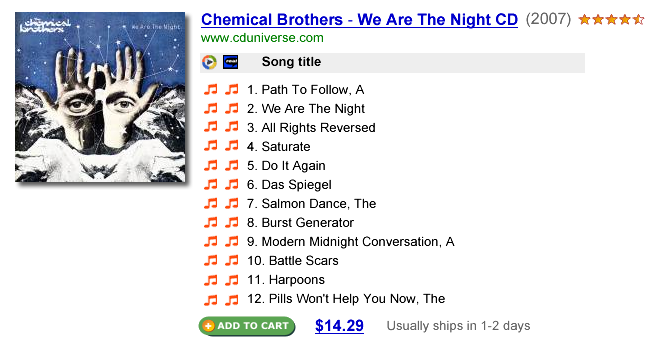本頁說明如何為自己的網站自訂搜尋結果摘要。如要轉譯自訂程式碼片段,您必須在網頁中加入結構化資料。
總覽
程式化搜尋引擎會顯示「網頁摘要」,讓使用者能大致瞭解網頁內容,進而協助使用者找到正確的網頁。如要進一步瞭解摘要,請參閱這篇有關搜尋結果剖析的網站管理員中心網誌文章。如果您不喜歡由程式化搜尋引擎演算法建立的標準程式碼片段,您可以自行建立程式碼片段。您可以直接在摘要中展示重要資訊,例如圖片縮圖、摘要、日期、作者、評分和價格。如果在搜尋結果中提供關聯性最高的資訊,就能提高您網站中的網頁對使用者的吸引力。
下圖說明自訂搜尋結果中摘要的各種方式。
圖 1:包含評分、價格範圍和評論的結果程式碼片段。

圖 2:包含格式設定、連結、圖片和比較資訊的結果程式碼片段。

圖 3:包含文件類型、作者、網頁瀏覽和註解的結果程式碼片段。

圖 4:格式豐富的結果程式碼片段,提供多媒體存取權和按鈕 (「加到 CART」)。

使用程式化搜尋元素建立複合式搜尋結果
基本上,建立複合式搜尋結果的步驟如下:
- 在網頁中提供結構化資料。
當程式化搜尋引擎為網頁建立索引時,程式會辨識並保留中繼資料。
- 在程式化搜尋引擎的搜尋結果中擷取該結構化資料。
程式化搜尋引擎伺服器可傳回搜尋結果,以及 JSON 格式的結構化資料。
- 建立簡報圖層,將結構化資料轉換為格式化 HTML。
「呈現層」是一組程式碼 (例如 JavaScript、PHP、JSP 和 ASP),可將原始資料轉換為向使用者顯示的格式。如果是程式化搜尋引擎,您可以:
- 請使用 Programmable Search Element 轉換 JSON 輸出內容,以便向使用者顯示。
- 自行撰寫自訂呈現層,使用搜尋元素回呼將 JSON 資料轉換為 HTML 向使用者顯示。
如要進一步瞭解結構化資料擷取功能,請參閱結構化資料頁面。如要進一步瞭解如何運用程式化搜尋元素建立顯示圖層,請參閱 程式化搜尋元素頁面。
探索其他功能
自訂程式碼片段也適用於其他程式化搜尋引擎功能:
- 如要進一步瞭解如何變更結果的順序,請參閱「深入探索搜尋結果」一文。
- 如要進一步瞭解 Google 支援哪些結構化資料,請參閱提供結構化資料一文。
- 如要進一步瞭解 Programmable Search Element,請參閱「 程式化搜尋元素說明文件」。
